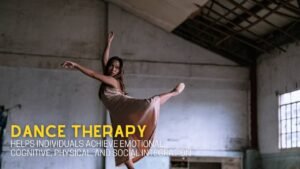Dance Therapy
(Fitness with fun)
Blog by: Team HealMe
Checkout more blogs: https://healme.in/knowledge-section/
Checkout healthy products: https://healcart.in
Dance/movement therapy, sometimes known as DMT or just dance therapy, is a type of therapy that use movement to assist people in achieving emotional, cognitive, physical, and social integration. Dance therapy can be utilised for stress reduction, disease prevention, and mood management, and is beneficial for both physical and mental health. DMT’s physical component also promotes muscular strength, coordination, mobility, and a reduction in muscular stress. Individuals, couples, families, and groups can all benefit from dance and movement therapy. Dance therapy, in general, increases self-awareness, self-esteem, and a safe space for emotional expression.


What kind of issues can Dance Therapy help with?
Dance therapists work with clients in treatment to improve their self-esteem and body image. Dance/movement therapy is a diverse type of treatment that is based on the concept that motion and emotion are inextricably linked. Dance therapy’s artistic expression can help to improve communication skills and foster dynamic connections. It’s used to treat a variety of medical, psychological, cognitive, and social disorders, including:
Physical Issues:
- Chronic pain
- Childhood obesity
- Cancer
- Arthritis
- Hypertension
- Cardiovascular disease
Mental Health Issues:
- Anxiety
- Depression
- Disordered eating
- Poor self-esteem
- Posttraumatic stress
Cognitive Issues:
- Dementia
- Communication issues
Social Issues:
- Autism
- Aggression/violence
- Domestic violence trauma
- Social interaction
- Family conflict
How effective is dance therapy?
Dance therapy has been shown to be useful in the treatment of mental health conditions such as disordered eating, depression, and anxiety in studies. Here are a few recent examples:
Dance therapy had a good effect on participants experiencing depression symptoms, according to a study published in the journal The Arts in Psychotherapy (2007).
- In a research published in the American Journal of Dance Therapy in 2004, 54 students took part in a dance therapy violence prevention programme, and aggression dropped while pro-social behaviours improved.
- According to a research published in Alzheimer’s Care Today in 2009, DMT can improve memory recall in patients with dementia.
- DMT may be a treatment option for children on the autistic spectrum, according to a literature study published in the American Journal of Dance Therapy.
- Dance/movement therapy is being investigated as a therapeutic option for childhood obesity due to its social and physical components.
History & philosophy of Dance Therapy
The origins of dance therapy can be traced back to the nineteenth-century contemporary dance movement. The premise behind the movement was that dancing could be utilised for more than just entertainment and could be used as a means of communication and expression. In other words, dancing was imbued with emotional content. Marian Chace, Mary Whitehouse, and Trudy School were dance therapy pioneers by the middle of the twentieth century, thanks to the contemporary dance movement. By including observation, interpretation, and manipulation of dance aspects into the practise, they laid the groundwork for dance therapy.
